National Award 2023
2023 Industry Master Award - Yu-chi, Sung
National Taipei University of Technology (NTUT) Distinguished Professor Yu-chi Sung has long been involved in construction disaster prevention engineering, bridge engineering, and offshore wind power engineering, and is a well-known expert in bridge engineering and earthquake engineering in Taiwan. He is a well-known expert in bridge engineering and earthquake engineering in Taiwan. He has led the development of the “Software for Detailed Evaluation of Reinforced Concrete Buildings for Earthquake Resistance” (SERCB) and the “Software for Preliminary Seismic Evaluation of Reinforced Concrete Buildings for Earthquake Resistance” (PSERCB), which are provided to the industry free of charge, and has made significant contributions to the government's policies of promoting public safety inspections of buildings, the reconstruction of old and dilapidated buildings, and the renewal of the urban areas.
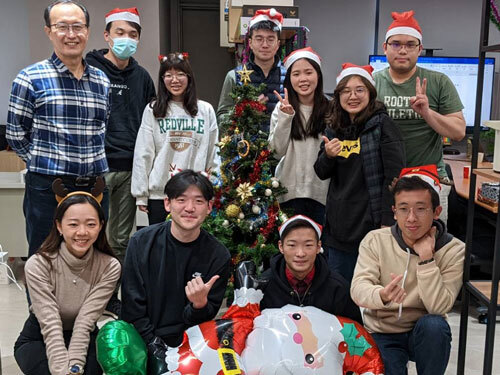
Mr. Sung has also implemented a number of government offshore wind power projects, developed support structure and design analysis software, and assisted domestic consulting firms in analyzing and designing support structures. During his more than 20 years of teaching, he has taught more than 10 courses related to structural, seismic, and wind power engineering as well as cross-disciplinary courses, helping students to build up their basic and advanced knowledge, and has made far-reaching contributions to the cultivation and inheritance of construction talents in both academia and the industry. He has also received the “Outstanding Contribution to Civil Engineering Education Award” from the President, a well-deserved award from the National Industrial and Academic Masters Award.
Coming from a poor family, he chose to study at Taipei Institute of Technology.
Yu-chi Sung grew up in a poor family, but his parents did their best to support the three children in the family. As the eldest son, he wanted to work as soon as possible to supplement his family's income, so he chose Taipei Institute of Technology (the predecessor of National Taipei University of Technology) as his first choice. At that time, his scores reached the entrance standard of civil engineering and chemical engineering, but he was not interested in chemistry, so he chose civil engineering. Taipei Institute of Technology has always been known for its seriousness and quality of students. More than 40 years ago, the level of students who could get into the school was high enough to attend star high schools such as Chien Kuo and Taipei First Girl's High School; at that time, as many as 140,000 applicants applied for the five colleges and universities, but in the end, only a few hundred of them were admitted to Taipei Institute of Technology, which made the competition very fierce and predictable.
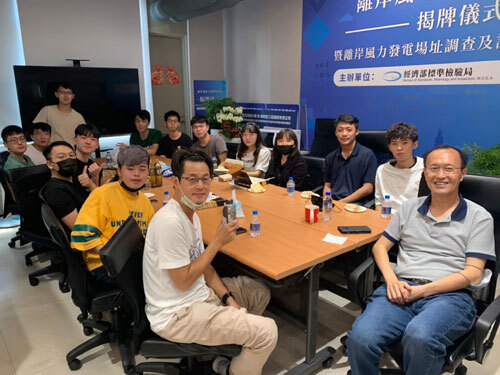
After graduating from Taipei Institute of Technology, he wished to continue his education. After taking the exam for Reserved Officer Service, he took the public service entrance examination while serving in the military, and was sent to the Highway Bureau to work as a bridge designer, and at the same time, he also obtained a civil engineer's license, and after one year's service, he was successfully admitted to the Institute of Power Mechanical Engineering of National Tsing Hua University with the same qualifications as a university, fulfilling his dream of studying. As a filial son, he took home all the money he earned while working as a prefect and in the Highway Bureau to share the household expenses with his parents.
Back to School Evaluation of Seismic Capacity of Research Buildings and Bridges
After graduating from the graduate school, Yu-chi Sung worked as an engineer in the well-known China Engineering Consultant, Inc. , engaging in the design of bridges and road works, and at the same time obtained a structural engineering technician's license. “Just went to do everything from the grassroots, quite hard, participated in the design of Gaoping River cable-stayed bridge, at that time, the key technology is mastered by foreign companies, the inner wish to hope that within a short period of time to understand the core technology, will know how to rooted in Taiwan.”
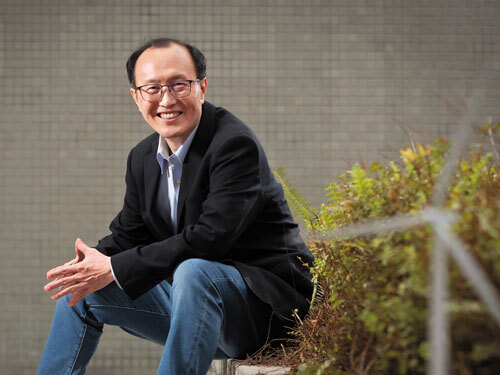
Before long, he faced the greatest challenge of his career. His superior assigned him to be responsible for the design project of the Maoluo Creek Steel Arch Tower Cable-Stayed Bridge. He was required to submit the design drawings, structural calculations, construction specifications, and all related materials within a year of receiving the project. Due to contractual restrictions, if he failed to deliver, he would have to pay a penalty for breach of contract. Yu-chi Sung aspired to achieve the goal of independently analyzing and designing by himself. Despite the immense pressure, he persevered with extraordinary determination, diligently researching relevant theories through Chinese, English, and Japanese literature. He even derived formulas and developed programs on his own. During this period, he even dreamed about solving equations while sleeping. “Once, I dreamt of a solution and woke up immediately. I was so excited that I couldn't go back to sleep. At 6 a.m., I rushed to the office to input the solution I had dreamed of into the computer, but unfortunately, it still failed.” After numerous attempts and failures, he finally succeeded in completing the project.
This arduous journey, filled with setbacks and challenges, made Yu-chi Sung realize that his expertise still needed improvement. At that time, Professor Yeong-Bin Yang from the Department of Civil Engineering at National Taiwan University encouraged him to pursue further studies. However, he had already established a family and career, with a wife and children to care for. After three years of deliberation, he thought, “If I don't pursue a PhD in this lifetime, I might regret it when I'm on my deathbed!” With his wife's full support, he applied for a leave of absence from his job and, at the age of 36, enrolled in the PhD program in Civil Engineering at National Taiwan University.
His advisor at National Taiwan University was the renowned bridge seismic expert, Professor I-Chau Tsai Initially planning to research bridge-related engineering, one day he read the ATC-40 (Assessment and Strengthening of Concrete Buildings for Seismic Performance) provided by Professor Tsai. This sparked his interest, leading him to focus his research on the development of theories and methods for evaluating the seismic capacity of structures. At the age of 39, he successfully obtained his PhD and returned to his alma mater, National Taipei University of Technology, to take up a teaching position.
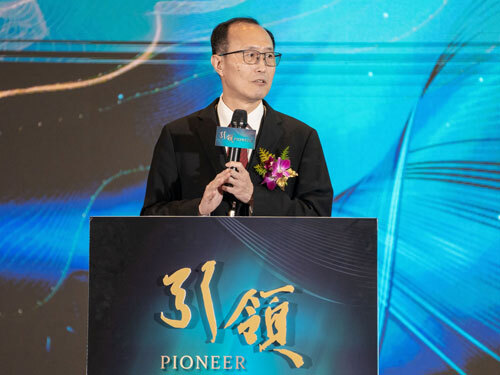
He developed seismic evaluation software and made it freely available to engineers and architects across the country.
During his tenure at National Taipei University of Technology, Yu-chi Sung's passion for academia continued to grow. He enjoyed teaching while actively engaging in research. Among his most significant contributions were the development of the industry's leading “Seismic Evaluation and Retrofit of Concrete Buildings” (SERCB) software and the “Preliminary Seismic Evaluation of Reinforced Concrete Buildings” (PSERCB) software. Given Taiwan's location on the western edge of the Pacific Ring of Fire, earthquakes are frequent. According to statistics from the Ministry of the Interior, there are currently about nine million buildings in Taiwan, many of which are over thirty years old (designed and constructed before the 921 Earthquake) and may not withstand the next major quake. He thought, “If there were software to evaluate the seismic capacity of buildings, it could help the government and the public to reinforce or rebuild them in advance, potentially preventing many tragedies.”
The SERCB and PSERCB software developed by Yu-chi Sung's research team are provided completely free of charge to certified engineers and architects nationwide. “We promote these tools through book publications, workshops, and online Q&A sessions. The SERCB software has been available for 15 years and is updated automatically each year for the engineering community. The PSERCB software has been available for 8 years and has accumulated over 20,000 data entries. These tools have significantly contributed to government initiatives for reconstructing unsafe buildings, accelerating urban renewal, and shaping disaster prevention policies. We hope to continue contributing to earthquake and disaster prevention engineering.” Additionally, another software, “SERCB for Bridges” offers seismic evaluation and retrofit solutions for bridges. The team has also developed a bridge monitoring system that effectively provides real-time structural safety monitoring.
In recent years, Yu-chi Sung has led his laboratory to delve into offshore wind power engineering research, independently developing software for the analysis of wind power support structures. Currently, the analysis software used in Taiwan's industry is almost exclusively developed abroad, with each software package costing around five to six million NT dollars. To handle tens of thousands of load combinations, the engineering community must send data to foreign manufacturers for analysis via cloud services, costing several million NT dollars each time and retrieving only partial data, which is time-consuming and expensive. Mr. Sung illustrated that analyzing all load combinations using traditional methods takes about 2.5 years. However, his laboratory's improvements have reduced this time to just 15 days. Additionally, analyzing the fatigue stress on tubular structure joints caused by a single load traditionally takes at least 13 hours. The new theory proposed by his laboratory shortens this to just 10 seconds. The related research results have been published in international journals. Currently, the laboratory has assisted several consulting firms in analyzing and designing support structures and is executing multiple government-related offshore wind power projects.
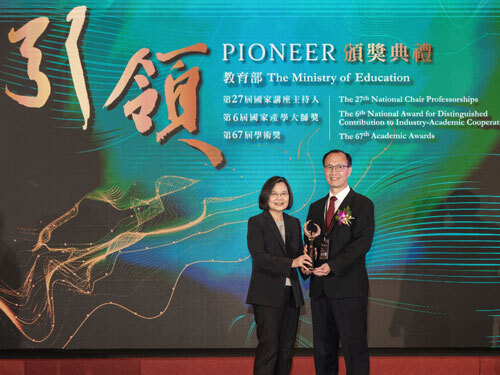
Giving up high salary for teaching job shows passion and romance of civil engineers.
After switching from industry to academia, Sung is more than satisfied with his life, even though an engineer's salary is several times that of a faculty member. Many people ask why he doesn't sell the free software he helped develop, SERCB and PSERCB. He thinks, “The traditional manufacturing industry wants to create more profits, while we in disaster prevention seek fewer disasters and fewer casualties. Although we can not create tens of millions of dollars or hundreds of millions of dollars in revenue, but we do research, the purpose is to save people, human life is priceless. When we first developed this software, we set it up to be free for everyone to use, and we will continue to do the right thing.”
Yu-chi Sung said, civil engineering students can apply what they have learned on the surface of the earth, design, build a variety of buildings, bridges or dams and other structures, for people to build bridges and pave the way, build buildings for shelter from the wind and rain for the welfare of the country and the people's work, although the money earned is not as much as today's popular science and technology industry, but it is a very meaningful work. “I always tell my students that as long as they are willing to work hard and be serious, they will have the opportunity to develop their career in any field.”
Commitment and Leadership in Nurturing Excellent Civil Engineering Talents
The most classic example of Sung's passion for teaching and research is that when he was teaching structural engineering, he took the initiative to add one hour of class to the three hours per week required by the school, which has been uninterrupted for the past two decades. He hoped that his students, who would apply for the exams of civil engineer or structural engineer after graduation, would have a solid foundation in structural engineering, and therefore he was willing to spend more time on it, and the students were able to realize the painstakingness of the teacher in the future. To further enhance his students' competitiveness, he adopts bilingual instruction in both Chinese and English during his classes, helping them not only master the professional knowledge but also become proficient in professional English. Over the years, he has supervised 15 PhD candidates and 82 master's students, and has published over 300 papers in domestic and international journals.
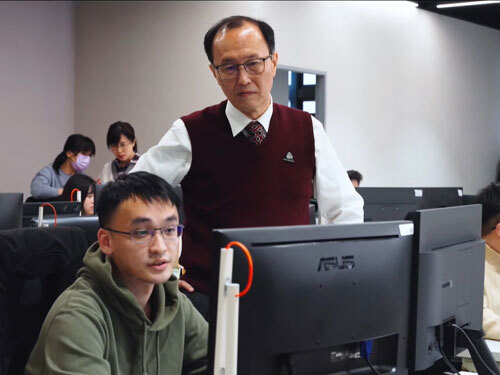
One summer weekend late at night, Yu-chi Sung, who lives near the school, spontaneously decided to call his lab. He thought that if any students were still there, he would treat them to ice cream. “To my surprise, more than ten students were still burning the midnight oil in the lab. I had to ask them to ride their scooters to the shop to bring the ice cream back,” he recounted. He and his wife then joined the students in the lab, chatting and enjoying the ice cream together.
Kou-Hung Chao, who graduated from the doctoral program last year, has been a student of Yu-chi Sung since his university days, and praises his teacher's structured matrix teaching method. He says that his teacher is very busy and strict, and that every weekend becomes an intense meeting time, which was uncomfortable for all of them at first, but over time, they have developed the habit of thinking and learning spontaneously, hoping to do the best in the research; unknowingly, the teacher and students have built up a sense of suffering between them.
Another PhD student, I-Yan Chen, has been working with Yu-chi Sung on offshore wind power engineering research for several years. In his view, Professor Sung, with his engineering background, possesses a unique vision, practical approach, and forward-thinking mindset. He is always unafraid to tackle new challenges and frequently organizes study groups, inviting experts from marine engineering, structural engineering, wind power, and other fields to discuss how to optimize offshore wind power. Despite most developers and investors being abroad, Professor Sung actively establishes communication channels, doing his utmost to gather forces from various sectors and integrate resources to benefit the domestic industry.
Yu-chi Sung's dedication to academia and his students earned him the “Outstanding Contribution to Civil Engineering Education Award” from the Taiwan Professional Civil Engineers Association in 2022. The award was personally presented by President Ing-wen Tsai, recognizing his continuous research into innovative construction methods and his exceptional contributions to nurturing talented civil engineers.
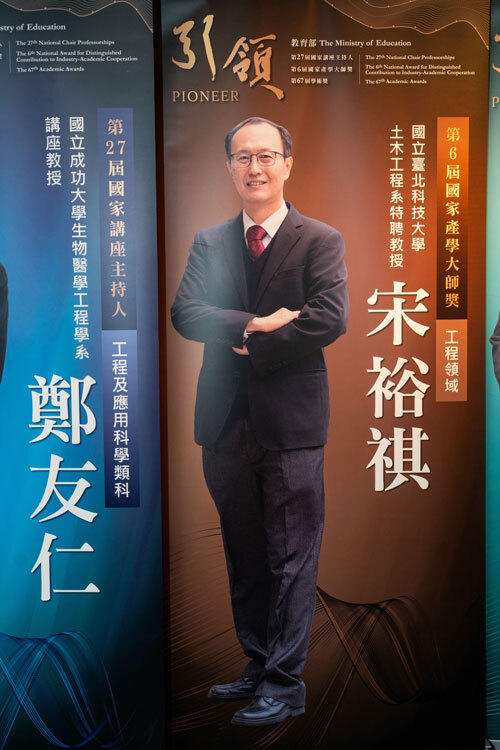
Thanks to his wife's support, he is the envy of others.
Yu-chi Sung would like to thank many people for winning the National Master of Science Award. He would like to thank his parents, who have nurtured him since he was a child and never let him suffer. He would also like to thank Mr. Pi-Ling Huang, Mr. Tsai Jin-Kun, and Mr. Tien-fu Peng when he was studying at the Taipei Institute of Technology; Mr. Kuan-Ya Yuan, professor at National Tsing Hua University's Graduate School of Engineering; Mr. I-Chau Tsai, professor at the doctoral program of the National Taiwan University; as well as Prof. Yeong-Bin Yang, Mr. Qing-Quan Zeng, vice president and Mr. Di-Wei Chang, manager of the Engineering Division of China Consultants, who have encouraged him. Under the guidance of his teachers and officers, he learned a lot of engineering theories. Later, he took over a large-scale bridge project and learned how to lead a team from practice, which are important nutrients for others to grow.
In addition, Mr. Sung is grateful to his wife, who has been with him all along the way, for her unconditional support at every important stage of his life. When he decided to go back to school to get his doctorate, he relied on his wife to support the family for several years, and the only pastime he and his wife had was to take their daughter to enjoy the lotus at Drunken Moon Lake in National Taiwan University; despite the lack of material goods, they still felt happy and satisfied.
The year before last, Sung's wife suffered serious side effects from a vaccination and was paralyzed in bed. At that time, the epidemic was so severe that she insisted on staying home instead of going to the hospital. As it was difficult for her to walk, Yu-chi Sung acted as a “human crutch” until she gradually recovered. “My wife has been by my side all the way, so of course I had to be there for her to get through it.” This shows the couple's strong bond.
Looking back on this journey, Mr. Sung pointed out that the most important thing in research is "vision", and that civil engineering applications are far-reaching. Now that the world is moving towards AI, civil engineering is facing a serious labor shortage. "Nowadays, the world is moving towards AI, and civil engineering is facing a serious labor shortage, so we have to keep up with the times as the design, construction, and maintenance of civil engineering projects are all going to be automated. As time progresses and technology is constantly evolving, he encourages students to keep in touch with new things and not to be complacent with their current achievements; Offshore wind power engineering will be the focus of global energy transformation, and the young generation will have a chance to take their place in the international arena if they work hard and conscientiously.
